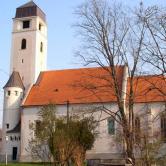Sights > Church of the Holy Cross
The Church of the Holy Cross is characterized by many layers of history, as well as some specific urban features. The church was built outside the Lower town walls, within a separate fortification. It was first mentioned in 1232. The well preserved side portal and some smaller monophores dating from this early period of the church building indicate that the church had been significantly smaller. The current sanctuary layout with the polygonal cross-ribbed vault dates back to the 15th century, pertaining to the late Gothic period. The Gothic style renovation ended in 1498, which is the year carved on the decorative sacristy portal dating from the late Gothic period. The Church of the Holy Cross has been renovated and redecorated lots of times over many years of its existence. The bell tower was reconstructed in the 16th century, during the Renaissance period, and the nave was changed in the 18th century, during the Baroque period.A legend has it that in the 6th century, when they first came to the area of Križevci, the pagan Croats who were tired and thirsty, had a vision of a Cross which quenched their burning thirst as they leaned over a well. It was this site of revelation that the Church of the Holy Cross was built on, and it still stands there today.
The Church remained closed for almost a century, since in 1788 the seat of the parish was transferred to the Pauline Church of St Ana, which remained empty after the Pauline order was abolished. In 1833 the Church of the Holy Cross was reopened, and shortly thereafter (in 1913) a thorough restoration was carried out according to the design of architect Stjepan Podhorski, who tried to retain all the styles the church had gone through. The architect himself wrote about this process: After a long dispute with the supporter of a neo-gothic style building, Mr Kršnjavi, the commission managed to win, and the project of Mr Podhorski was approved in 1912. Thus, the Church of the Holy Cross became the first monument in Croatia to be renovated according to the new conservation methods described by Gjuro Szabo. One of these methods reads: According to current understanding, each building should remain intact, while only the insipid aggregations should be removed. Thus the Church took on its present appearance.A legend has it that after receiving the altar from Zagreb, several oxen took turns transporting the valuable, but heavy altar to Križevci. The people were relieved once it was safely transported to the Church of the Holy Cross.
The church keeps one of the most precious late Baroque altars carved out of marble in 1756 by Francesco Robba, a famous sculptor of Italian origin, based in Ljubljana. The altar originally belonged to the Cathedral in Zagreb, where it stayed until the Cathedral was renovated in the late 19th century. Since it did not fit in with the neo gothic style of the newly renovated Cathedral, it was moved to Križevci. According to the experts, the altar may be regarded as one of the most precious late Baroque sculptures in Croatia, and an attraction the tourists who visit Križevci must not miss. We should also mention Oton Iveković's oil painting called Križevci Bloody Assembly which is displayed on the arch. It was maid in 1914 and is considered to be one of his largest works, since it is more than 8 meters long.
The Church of the Holy Cross ordered the painting (which had rarely happened in Oton's career) following a Historicist Art Deco renovation carried out by architect Stjepan Podhorsky in 1913. The painting is displayed above the arch and has an unusual shape, subject to the architecture of the church-the lower part of the painting stretches along the line of the gothic arch, while the upper part ends in a semicircular shape, like the wall itself, so the painting actually resembles a large fresco covering the wall. The painting is displayed in the most conspicuous place in the Church: on the arch, in front of the sanctuary, so people can often turn their eyes towards it. The church is the very site of the bloodshed, as well as the place where people get together, and the altar is the most sacred place in the church. Above this sacred place there is a message to the people, In memoriam.
That's why this painting isn't just one of the many paintings showing some historic event. It is also a monument, not only in terms of history and culture, but also in terms of being a reminder of a significant and tragic historic event, which, according to some experts, took place in the Church itself. It is because of this painting, that this sacral building is turned into a kind of memorial.






